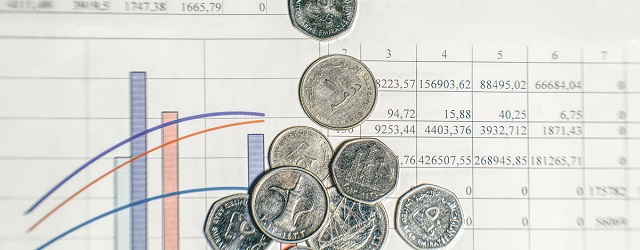GCC-based countries are drawing down their foreign exchange reserves to protect their dollar pegs and tapping global debt markets for record amounts, along with corporates.

Countries and corporates based in Gulf Cooperation Council (GCC) states are taking advantage of low interest rates and eager investors to issue large amounts of bonds. Altogether, borrowers from the region raised a record $101 billion through bond placements last year, and this year’s total is likely to set a new record.
The surge comes at a time when syndicated loans are declining, thanks to lower oil revenues and economic weakness caused by effects of the Covid-19 pandemic and governments’ subsequent postponement or cancellation of major projects.
“Even in the current turbulent environment, there is ample market liquidity and interest by global investors for GCC corporate issuers that have business models with strong competitive advantages,” says Rehan Akbar, senior credit officer at Moody’s Europe, Middle East and Africa Corporate Finance Group in Dubai. “As an example, Equate Petrochemical [based in Kuwait] was able to successfully issue $1.6 billion of bonds in mid-May, even though the petrochemical industry is facing a challenging time.”
Despite the oil-price drop, Saudi Aramco sold $12 billion worth of bonds in April 2019 and attracted $100 billion in offers, demonstrating that investor demand remains strong in light of an ongoing search for relatively safe but higher-yielding securities. Mubadala, Abu Dhabi’s sovereign wealth fund, sold $4 billion in a three-part bond offering in May 2020, attracting orders worth nearly six times that amount. The offering included $2 billion of dual-listed Formosa bonds, sold in Taiwan and listed on the Taipei Exchange, which provides financial products and trading services to the international market.
Issuance of sukuk, or shariah-compliant financial certificates similar to bonds, is also expected to pick up.
“Sharply lower oil prices imply significantly larger funding needs for the major sukuk issuers in the GCC, including Saudi Arabia, Qatar and Oman,” says Alexander Perjéssy, senior analyst in the Sovereign Risk Group at Moody’s Investors Service Middle East in Dubai. “This likely means higher sukuk issuance this year; although we would expect the majority of external borrowing by these sovereigns to remain in the form of conventional bonds, as has been the case in the last several years.”
Saudi Arabia has been offering about $2 billion monthly this year in local sukuk denominated in Saudi riyals. The monthly sukuk program was introduced in 2017, and the sukuk yield curve was extended in April 2019 with a 30-year offering. Saudi Telecom also has established a riyal-denominated sukuk issuance program through local private placement.
Other countries are issuing bonds to avoid drawing down their foreign exchange reserves and to make up for declining fiscal revenues. “We recently revised our average oil price assumptions to $35 a barrel in 2020 and $45 a barrel in 2021; and as a result, we expect a very large drop in fiscal revenues for all GCC sovereigns,” Perjéssy says.
“The governments that have fiscal buffers—which are typically distinct from central bank foreign currency reserves—have an option to finance some of their fiscal deficits and debt repayments by drawing down these accumulated financial assets whenever market conditions are unfavorable, or just to reduce the rate of debt accumulation,” he adds. “Saudi Arabia and Oman have been doing this extensively since 2015. Qatar, in contrast, has avoided dipping into its asset pool and continued to borrow, and accumulate debt, even as it ran a fiscal surplus in 2018 and 2019.”
Saudi Arabia was first out of the gate with a bond issue in January, taking advantage of low borrowing costs to issue $5 billion of eurobonds in seven-, 12- and 35-year maturities. The seven-year tranche was priced at 85 basis points over US Treasuries and yielded 2.54%. The 12-year offering was priced at a spread of 110 basis points and yield of 2.88%, while the 35- year portion yielded 3.84%. Citi, Morgan Stanley and Standard Chartered Bank led the eurobond offering. BNP Paribas, HSBC, JPMorgan Chase and NCB Capital of Saudi Arabia were also joint lead managers.
By the time Saudi Arabia returned to the bond market in April for a $7 billion offshore bond sale, the economic effects of the coronavirus were clearer and sinking oil prices dampened investor sentiment, widening spreads. The 5.5-year tranche was priced at 260 basis points over US Treasuries, the 10.5-year at 270 basis points above, and the 40-year issue—the kingdom’s longest-dated bond yet—carried a yield of 4.55%. Citi, Goldman Sachs, HSBC, Bank of China, Mizuho Bank, Mitsubishi UFJ Financial, Sumitomo Mitsui Banking and Samba Capital arranged the sale.
The pricing of the issue was less generous than for new issues from Abu Dhabi and Qatar earlier in April, however. Qatar, the world’s largest exporter of liquefied natural gas last year, raised $10 billion through a eurobond offering, attracting $45 billion in orders after offering a premium over its existing bonds.
Alternate Sources of Funding
Boosting last year’s record bond issuance was the phased inclusion of five of the six GCC states in J.P. Morgan’s Emerging Markets Bond Index. Oman, the sixth GCC country, had already been included in the index.
Sovereign issuers may be a bigger presence at the party this year. “We expect GCC sovereign debt issuance to increase to $67 billion for 2020 versus $52.9 billion in 2019, to finance the rising fiscal deficits,” says M.R. Raghu, head of research at Kuwait Financial Centre (Markaz). “As corporates are also active issuers, especially banks to shore up their capital, we expect last year’s overall total of $101 billion [for sovereigns and corporates] to be exceeded this year.”
Raghu attributes the switch to bonds from bank loans to low interest rates. “Further, governments and corporates alike are looking at alternate sources of funding for their investments and expenditures,” he says.
International investors are attracted to GCC bonds because they tend to earn higher credit ratings than most emerging market debt, while the yields are higher relative to developed-market bonds, making them attractive for yield-seeking investors, says Raghu. And GCC states with higher sovereign credit ratings, such as Qatar, the United Arab Emirates and Saudi Arabia prefer to raise debt at low rates than draw down their reserves.
“However, for Bahrain and Oman, which are rated below investment grade, issuing debt would be an expensive affair,” says Raghu. “Kuwait, which has a high sovereign credit rating, has not been able to issue debt since 2017 because authorization from Parliament has not been obtained to modify debt laws.”
Sukuk are increasingly used by both sovereigns and corporates to raise funds from investors who prefer shariah-compliant investments, he adds. “However, conventional bonds have a wider target market and it is easier and faster to raise money from international investors through bonds. Moreover, with major central banks unleashing liquidity in international markets and prevailing record-low interest rates, the outlook for conventional bonds appears to be bright over sukuk.”
But conditions are constantly changing. Through May, June and July Moody’s Investors Service was reviewing its Middle East ratings, delivering downgrades to Oman and Saudi Arabia while reaffirming its ratings of Kuwait and the UAE, citing their strong hydrocarbon and asset reserves.



